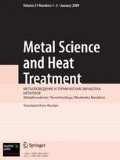Conclusions
-
1.
Heating of Ni-resist samples to 550–950° leads to considerable reduction of the stability of austenite with regard to the martensitic transformation, the largest rise of MS occurring at temperatures around 800°, while the maximum rate of the destabilization of austenite occurs at 500–700°. Destabilization of austenite is associated with the precipitation of carbides from it.
-
2.
MS is affected by the concentration of carbon dissolved in austenite, which increases with temperature above 550°, and the mechanical condition of austenite, which is determined mainly by the quantity and size of carbide particles precipitated within austenite grains; when the temperature is raised from 550 to 1000° the number of carbides decreases and the size increases.
-
3.
Overheating of engines leading to heating of Ni-resist cylinder sleeves to 550–900° cannot be tolerated, especially at low ambient temperatures, since the stability of austenite with regard to the martensitic transformation decreases in this case.
Similar content being viewed by others
Literature cited
GOST 11849-66, Izd. Standartov, Moscow (1966).
L. I. Aptekar' and Yu. E. Abramenko, "Structure and properties of austenitic nickel cast irons," Metalloved. Term. Obrab. Met., No. 4, 28 (1977).
V. N. Platonov, "Production and some physicomechanical properties of austenitic cast irons," in: Transactions of the Central Scientific-Research Diesel Institute [in Russian], No. 65 (1972), p. 9.
K. P. Bunin, Ya. N. Malinochka, and Yu. N. Taran, Fundamentals of the Metallography of Cast Iron [in Russian], Metallurgiya, Moscow (1969).
V. A. Zakharov, N. K. Lazareva, and N. P. Chichagova, "Stability of austenite in alloyed cast iron at low temperature," Metalloved. Term. Obrab. Met., No. 12, 49 (1970).
R. Ruhl and M. Cohen, Trans. Met. Soc. AIME,245, No. 2, 241 (1969).
A. Bradley, W. Cox, and H. Goldschmidt, J. Inst. Met.,67, No. 6, 189 (1941).
M. E. Blanter, "Martensitic transformation and mechanical condition of phases," Metalloved. Term. Obrab. Met., No. 5, 7 (1975).
M. E. Blanter and P. V. Novichkov, "Nature of the martensitic transformation," Metalloved. Term. Obrab. Met., No. 6, 11 (1957).
G. Cox, Brit. Foundryman,67, No. 11, 295 (1974).
Additional information
All-Union Correspondence Machine Construction Institute. Translated from Metallovedenie i Termicheskaya Obrabotka Metallov, No. 6, pp. 61–64, June, 1978.
Rights and permissions
About this article
Cite this article
Abramenko, Y.E., Aptekar', L.I. & Tiskovich, N.L. Conditions of stability of the structure of Ni-resist alloys. Met Sci Heat Treat 20, 494–497 (1978). https://doi.org/10.1007/BF00774000
Issue Date:
DOI: https://doi.org/10.1007/BF00774000




